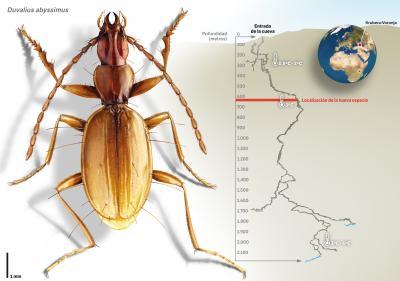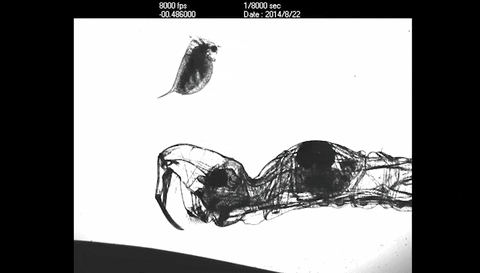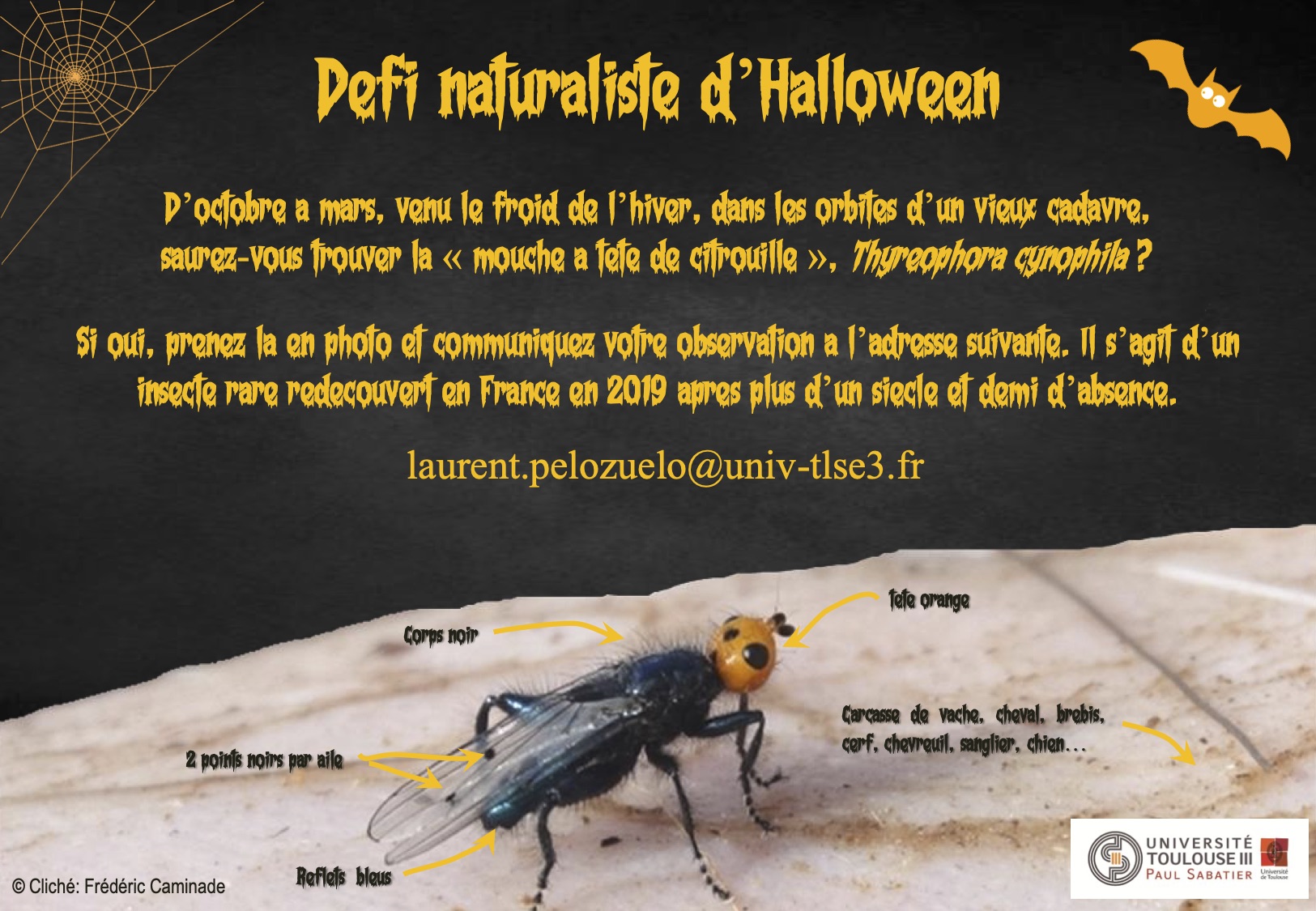The ability of insects to colonize and adapt to extreme environments and inhospitable habitats is increasingly surprising. The discovery of a beetle from the depths in the Krubera-Voronja underground galleries of the Arabika massif (Caucasus) bears witness to this. This carabic, Duvalius abyssimus, was collected at a depth of nearly 60 m during an exploration expedition led by a team of Ibero-Russian speleologists between 2010 and 2013.
The cave beetles were, historically, the first species adapted to underground life described. These insects make up an important part of the biodiversity of these habitats with a high rate of endemism: they constitute for that an interesting model of study of the evolutionary history and the adaptation of these species to this type of singular environment.
The Caucasus region is a biodiversity hotspot for the Carabidae beetles. Several genres are present: Jeannelius (Kurnakov, 1959), Meganophthalmus (Kurnakov, 1959), Caucasaphaenops (Belousov, 1999), Taniatrechus (Belousov & Dolzhanski, 1994), Caucasorites (Belousov & Zamotajlov, 1997).
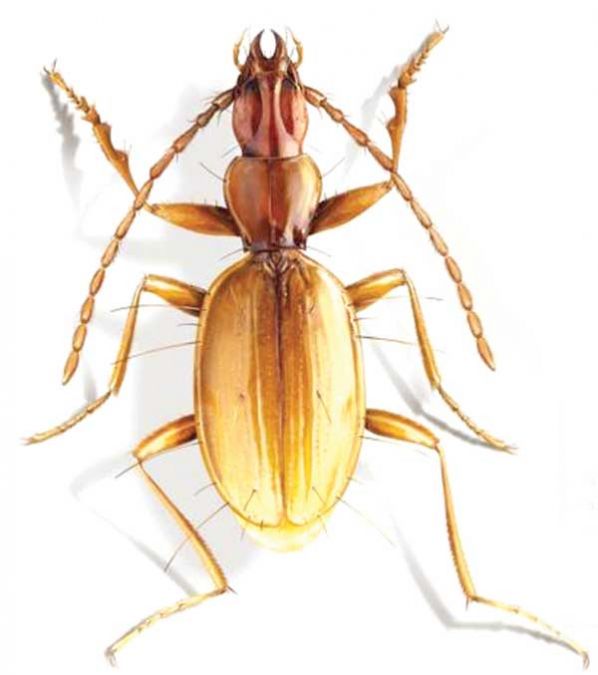
The genus Duvalius (Delarouzée, 1859) occurs throughout the Mediterranean area as far as Asia. It gathers 220 species divided into 9 subgenera: Biharotrechus (Bokor, 1922), Duvalius s.str., Euduvalius (Jeannel, 1928), Hungarotrechus (Bokor, 1922), Neoduvalius (Muller, 1913), Paraduvalius (Kirsch, 1924), Platyduvalius (Jeannel, 1928), Trechopsis (Peyerimhoff, 1908) and Typhloduvalius (Kirsch, 1980).
While these species have different external morphological characteristics, their determination is based on the study of their genitalia (male copulatory organs). However, a taxonomic revision of this kind is necessary to clarify its complexity.
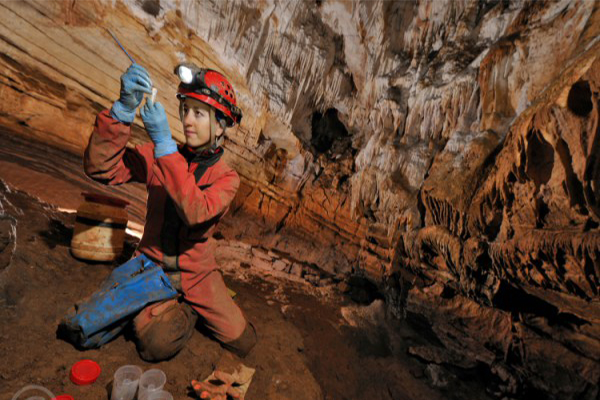
The genera Duvalius and Trechus are closely related (Trechini tribe) and present in the same geographical region. The species of these two genera are differentiated by the study of genitalia, endophallus (inner wall of the genital organ) and pubescence of the tibias.
A new species of the genus Duvalius : Duvalius abyssimus (Reboleira1,2 & Ortuño<3, 2014) was recently described following a speleological exploration mission carried out by an Ibero-Russian team between 2010 and 2013 in the underground galleries of the Arabika massif, west of the Caucasus ( see photos opposite/em>). Collected at a depth of 60 m, the two specimens (one male and one female) open new perspectives on the knowledge of the cave entomofauna.
Duvalius abyssimus is the third cave species of the genus described in the western Caucasus region. The other two are: D. miroshnikovi (Belousov & Zamotajlov, 1995), known from the Bariban and Sochi caves, and the Alek massif in Russia; D. sokolovi (Ljovuschkin, 1963) also occurs in the Arabika massif.
1-Department of Biology and CESAM, University of Aveiro, Santiago Campus, 3810-193 Aveiro, Portugal
2- Department of Animal Biology, Faculty of Biology, University of La Laguna, 38206 La Laguna, Tenerife, Canary Island
3- Department of Life Sciences, Faculty of Biology, University of Alcali, Madrid, Spain
Ecology & habitat
The Krubera-Voronja cave reaches a depth of 2140 m (it is the deepest known in the world). At the place where the specimens were collected (-60 m), the temperature is 3°C and the humidity is 100%. Despite these adverse conditions, other arthropods have colonized these galleries with varying degrees of adaptation: the pseudoscorpion Neobissium (Blothrus) birsteini (Lapschoff, 1940) which is the main and most widespread predator at this location where it cohabits with opilion Nemaspela (Silhavy; 1966) and the spider Troglohyphantes (Joseph, 1881), only found on the upper parts of the cave.
Most of this biocenosis (all living beings coexisting in a given ecological space) is composed of saprophytes (which feed on decomposing organic matter) : millipedes of the order Chordeumatida, a species of the genus Leucogeargia (Verhoeff, 1930) (Julidae), Collemboles Plutomurus ortobalaganensis (Jordana & Baquero, 2012) (Tomoceridae), Deuteraphorura kruberaensis (Jordana & Baquero, 2012) (Onychiuridae), Schaefferia profundissima (Jordana & Baquero, 2012) (Hypogastruridae), Anurida stereoodorata (Jordana & Baquero, 2012) (Neanuridae) and the beetle Catops cavicis (Giachino, 2011) (Leiodidae) (see photos opposite).
caption id=”attachment_3224″ align=”alignleft” width=”270″] Krubera-Voronja cave wildlife – A Pseudoscorpion – B and C Opilion – D Catops cavicis – E Troglohypantes sp. F Diplopode (Source : Reboleira)[/caption]
Krubera-Voronja cave wildlife – A Pseudoscorpion – B and C Opilion – D Catops cavicis – E Troglohypantes sp. F Diplopode (Source : Reboleira)[/caption]
Description of Duvalius abyssimus
The individuals collected measures 6.60 and 6.77 mm.
The species presents external morphological adaptations related to underground environments characterized by the total absence of light: reduced eyes (here limited to a few ommatidies, lire this article) and long, fine silks all over the body. The sense of touch replaces that of sight which has become useless.
caption id=”attachment_3215″ align=”aligncenter” width=”350″] Morphological description of Duvalius abyssimus – scale line : 1 mm (Source : Reboleira & Ortuno, 2014) (Modified by B. GILLES)[/caption]
Morphological description of Duvalius abyssimus – scale line : 1 mm (Source : Reboleira & Ortuno, 2014) (Modified by B. GILLES)[/caption]
Source :
– Reboleira A.S. & Ortuño V.M. (2014) : A new species of Duvalius from world’s deepest cave (Coleoptera : Carabidae), Zootaxa 3784(3):267-274

